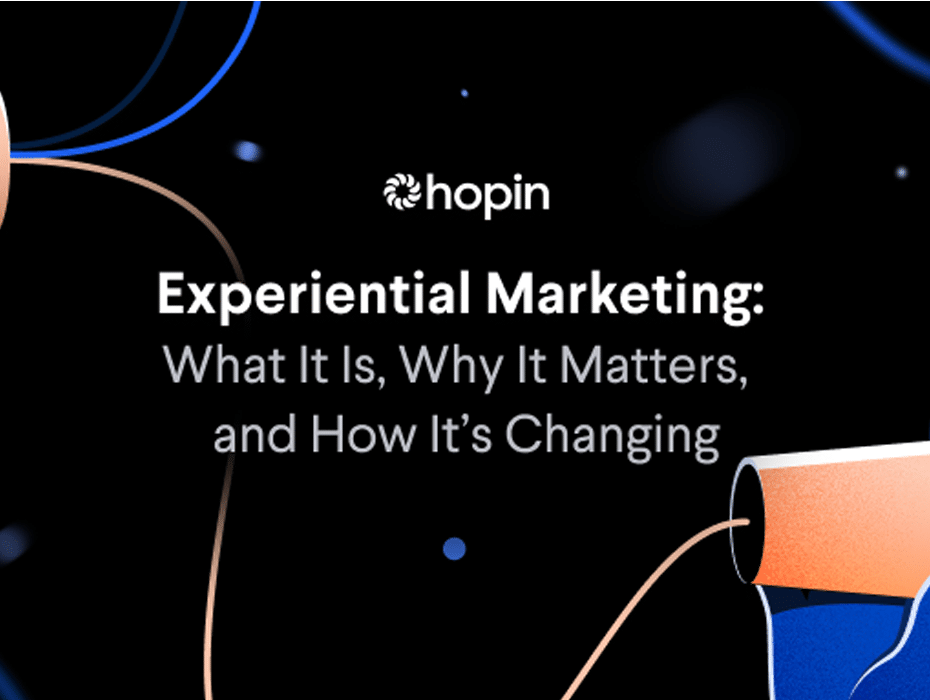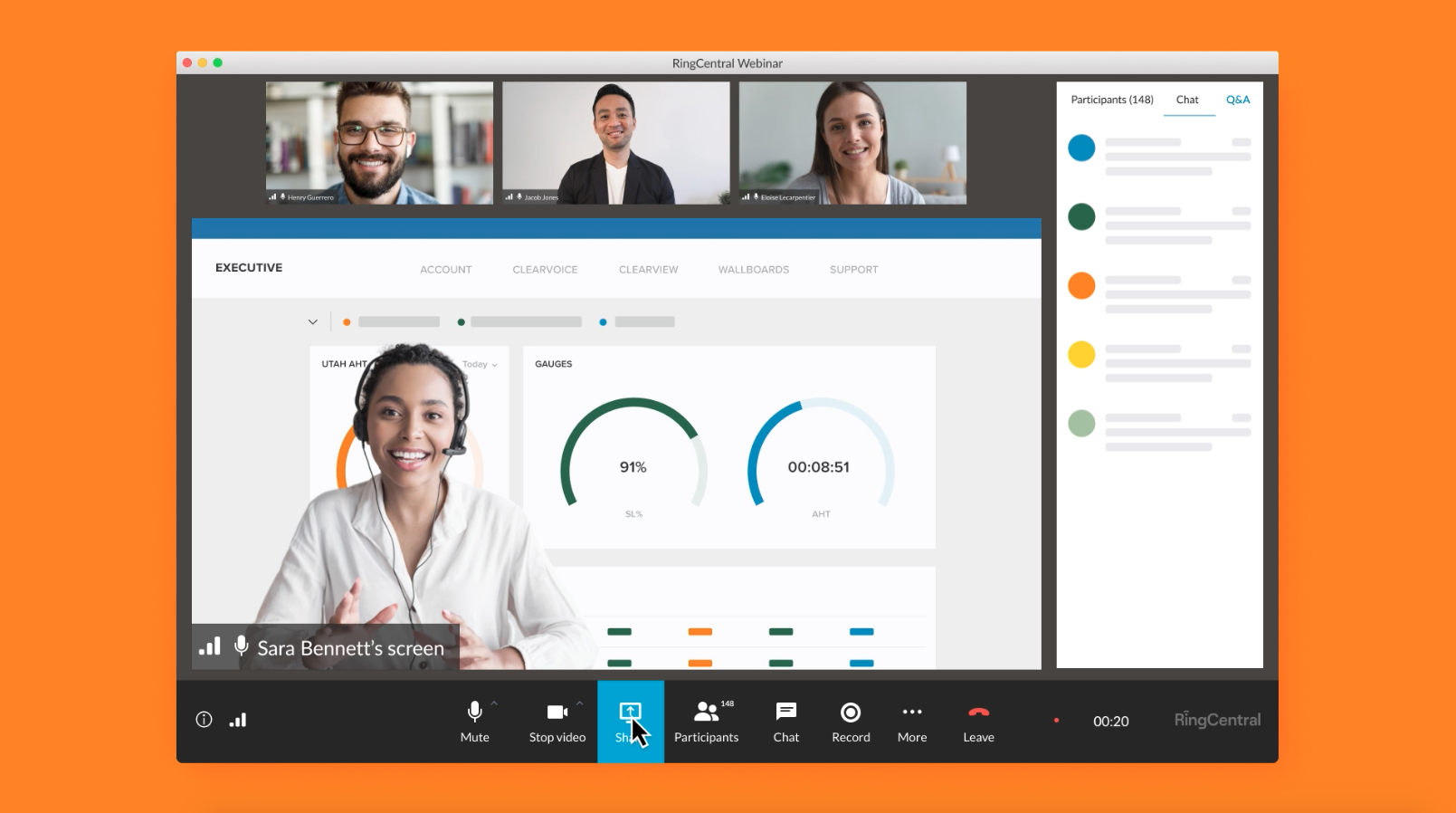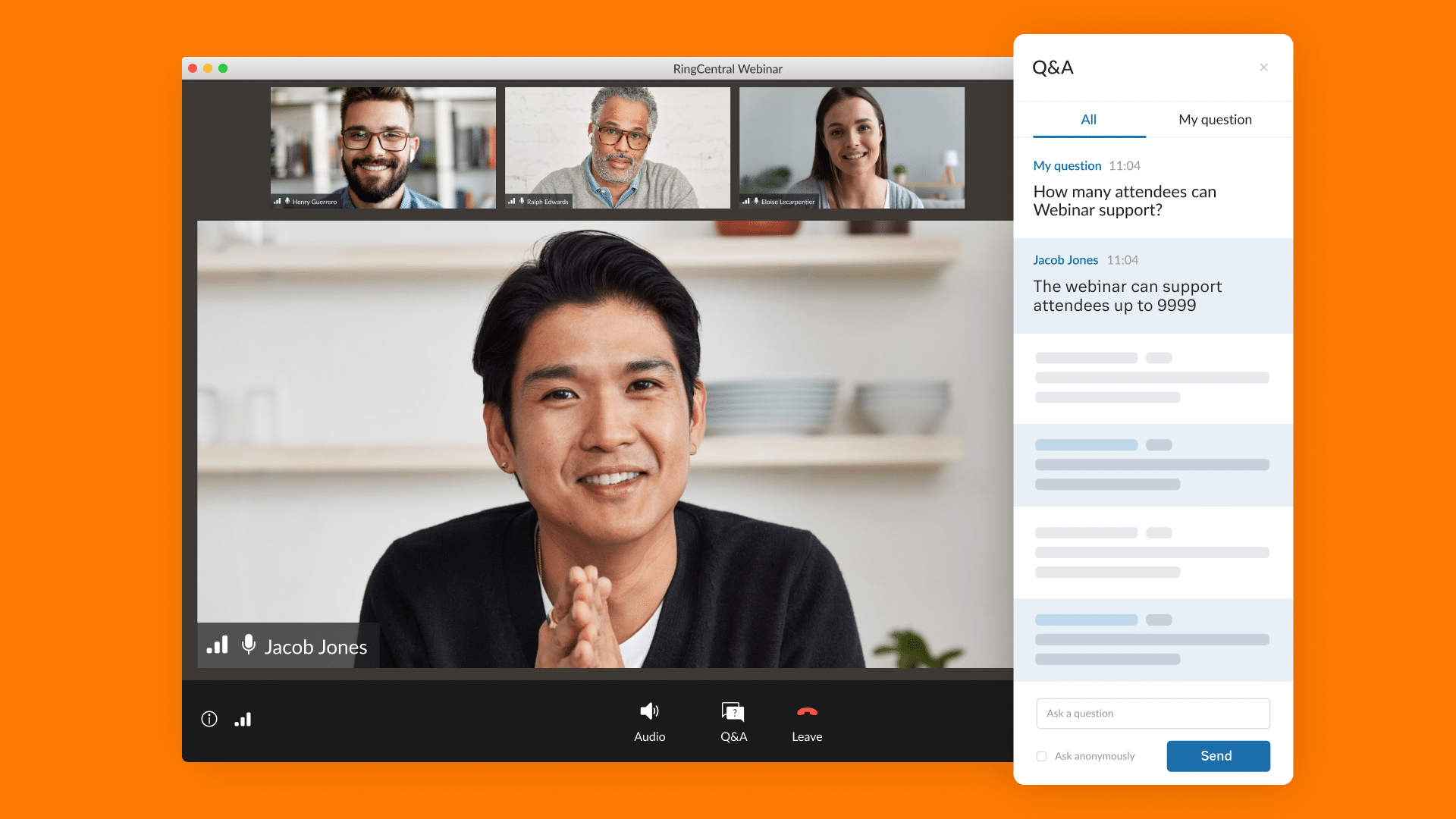Marketing and advertising have changed a lot in recent years. Not long ago, a brand could raise awareness and generate revenue through social media and search engine marketing. Those days are, unfortunately, coming to an end.
- Almost 65% of searches on Google produce zero clicks.
- The median Facebook page post reaches 0.08% of followers.
- The median Instagram post reaches less than 1.6% of followers.
- 85% of content earns fewer than 10 social shares.
We’re all wise to the easy plays now –– we know when we’re being marketed to. So today’s marketers have to up their game if they want to connect with their audiences.
Experiential marketing isn’t just a more effective strategy for brands looking to overcome these challenges — it’s also becoming an increasingly popular one.
In this guide, you’ll learn why experiential marketing is now taking center stage, what makes it so effective, and how to execute successful experiential marketing campaigns.
What is experiential marketing?
Experiential marketing is a way of engaging a brand’s customers via live interaction.
Brands create emotional connections with people by immersing their audiences in a product or service. Those connections help companies win new customers, keep current customers, and create loyal, long-term brand ambassadors.
Experiential marketing versus traditional and digital marketing
Let’s get some definitions out of the way first:
- Experiential marketing is a way to engage a brand’s customers via live interaction. It’s one channel in a multi-channel marketing strategy. It’s powerful because it creates emotional connections between customers and a brand.
- Traditional marketing usually refers to promotion that isn’t online. It includes print advertisements, billboards, radio commercials, and more. It usually focuses on differentiating a brand’s product or service (versus creating an emotional connection).
- Digital marketing is promotion that happens online. It includes everything from search engine optimization to social media to pay-per-click advertising.
Experiential marketing pulls from both traditional and digital marketing. Like traditional marketing, it meets customers in their own environments, creating physical interactions with a brand. Like digital, it allows for personalization and interaction.
But it’s different from traditional and digital marketing in two key ways.
First, experiential marketing plays on multiple senses — not just visual stimulation — to create an emotionally resonant experience. And second, experiential marketing’s goal is to create positive sentiment about a brand or product in general, not just to promote the sale of said product.
Take this example:
- A newspaper’s traditional marketing budget might go toward billboards. “Read our paper to stay informed on what’s happening in your community,” those billboards might say, touting statistics about investment in infrastructure or the arts.
- Their digital marketing budget would fund search engine ads. If you searched “events near me,” you might receive a Google ad for the paper’s local events section.
- Their experiential marketing budget might support a pop-up hybrid event. At said event, imagine readers searching for headlines on the day they were born and creating a personalized “front page” report they could access digitally, complete with audio snippets from key news stories of that time. That experience might not be focused on selling newspaper subscriptions or bringing in more readers. But by activating brand ambassadors and providing them with a compelling, personalized experience, the paper would enjoy stronger brand recognition and loyalty.
What experiential marketing isn’t
Experiential marketing isn’t the same thing as event marketing or influencer marketing, although it includes elements of each.
Experiential marketing is built around a long-term strategy to engage an audience through interactive branded experiments. While it definitely includes events, it’s not limited to events.
For instance, designing a beautiful company headquarters, complete with a branded photo booth and an interactive history exhibit, would count as experiential marketing. But said headquarters would be a permanent installation –– not a moment-in-time event.
It’s also not influencer marketing, which is using content creators to share your brand’s message on their platforms. Participants in your experiential marketing campaigns might share their experiences on social media, but you’re not targeting them for their platforms.
The growing popularity of experiential marketing
As mentioned earlier, experiential marketing has increasingly become the go-to strategy for brands. Let’s back up that claim with some numbers:
- Hybrid events provide new opportunities to engage an audience. 48% of event organizers say one of the main advantages of hybrid events is creating more opportunities for people to connect.
- Experiential marketing helps companies connect with consumers where they are. Nearly 50% of consumers were back to “normal” out-of-home activities, including attending events, in October 2021. With new variants looming, hybrid events will appeal to consumers who aren’t yet back to pre-pandemic interaction and to those who are.
- Early adopters are doubling down and new brands are signing up. 48% of marketers who used experiential marketing in 2021 plan to increase their investment in this type of marketing in 2022, and 9% of marketers plan to invest in it for the first time.
- Cross-channel coordination is here to stay. 75% of marketers engage customers in real time across multiple channels, including experiential channels like hybrid events. To support these activities, marketers rely on pre-produced video (81%), livestream video (73%), and virtual experiences (46%).
While marketers have been tapping into experiential marketing for some time now, the trend has accelerated in recent years.
Experiential marketing and the new normal
Before March 2020, experiential marketing was considered to be almost exclusively recurring, in-person events. These experiences included big-budget annual events, like expos or product launches, and smaller community events, like pop-ups.
But that changed with the pandemic. Conferences and pop-ups alike were canceled. So were the Olympic Games, South by Southwest, and your kids’ in-person schooling.
Then, those experiences came back.
At first, they were virtual. Fully digital events allowed people to connect safely and enabled a broader audience of people whose location, abilities, or resources kept them from participating in traditional events.
Then they went hybrid. In-person events returned with limited capacity and heightened safety measures. But they didn’t lose the best of virtual events: the inclusion, the interaction, and the creativity. The Tokyo Olympics piped in digital fans, South by Southwest introduced an online program that included live panels, meet-ups, and virtual spaces to explore.
Experiential marketing campaigns that use the best of in-person and virtual events are here to stay. They meet consumers where they are regarding convenience and comfort levels with interaction. They give marketers and companies unprecedented options for personalization, entertainment, and engagement.
And they blow marketers’ prior concept of reach out of the water. For example, Microsoft hosted 109,000 people at events in 2019 — and 1.3 million people in 2020.
Experiential marketing will mean hybrid experiences in 2022 and beyond.
Four undeniable benefits of experiential marketing
We’ve covered what experiential marketing is and isn’t. Now here’s why experiential marketing activations are so effective.
1. Experiential events better communicate the why for customers
Leave the special offers at home. One of the strongest buying triggers at marketers’ disposal is the ability to facilitate a positive feeling about their product among customers. A 2020 survey found that 83% of people are more likely to purchase goods from a brand they have an emotional connection to. Experiential marketing campaigns that elicit emotional responses from participants can create and deepen those connections.
2. Experiential events create deeper, more personal connections
No one wants to feel like a number. (There’s a whole Bob Seger song about it, in fact.)
Personalization helps customers feel special, like a brand is talking directly to them. A 2020 Salesforce report noted that 92% of marketers’ customers and prospects expect a personalized experience. In addition, 78% of marketers found personalization to have a “strong” or “extremely strong” impact.
Experiential marketing is built around the personal. From custom invites to thoughtful swag to immersive physical and virtual experiences, there’s no shortage of opportunities to get specific and make customers feel like the star of the show.
3. Experiential events are inherently engaging and memorable
The New York Times reported that people living in cities see up to 5,000 ads a day.
In 2007.
The market research firm that came up with 5,000 hasn’t updated their research since, but current estimates put it at around 10,000 ads per day in 2021.
That’s far too many ads to remember. Your brain has developed different kinds of “ad blindness,” including for banner ads and text ads, where it stops registering ads that come into view.
That’s if you even see ads at all. For example, 40% of American adults use an ad blocker.
Experiential marketing avoids all of that by creating novel, engaging touch points. And importantly, because experiential campaigns create actual value for your audience, they’re not skirting customer preferences –– they’re meeting them.
4. Experiential events offer more immediate and tangible value
Investing in experiential marketing might seem expensive, especially if the entirety of your marketing budget usually goes to Facebook ads and search engine marketing.
But unlike regular digital marketing, experiential marketing can create a self-perpetuating marketing machine. If you create an incredible branded experience your customers love, they’ll do the hard work of distributing that experience for you. They’ll make TikToks and Reels. They’ll post to their Stories. They’ll transform themselves into a whole team of microinfluencers.
That’s good for you: A 2021 study from an influencer firm found that 94% of consumers think microinfluencers, who can have fewer than 500 followers, are more credible and believable than those with bigger followings.
And you can then take that user-generated content (UGC) and turn it into more marketing. Per AdWeek, 85% of people find UGC to be more influential than content made by brands.
Not so expensive after all, right?
Ideas for experiential marketing events
Experiential marketing isn’t a one-size-fits-all approach. How could it be, if it’s infinitely personalizable?
If you’re looking for examples of experiential marketing types, start with one of these seven ideas:
Experiential marketing idea #1: Pop-ups
A classic of the genre, pop-ups are temporary shops or events hosted by brands to support marketing or sales goals. They can be geared toward building community, getting user feedback, creating hype for a brand, finding brand ambassadors, or making sales.
They’re often custom-planned around a certain aspect of a brand or a certain audience segment.
For example, Louis Vuitton often hosts pop-ups on upscale Rodeo Drive in Los Angeles that speak to the brand’s luxurious and creative identity. A 2021 edition was based on “the fundamental belief in inclusivity,” reported Travel + Leisure. It featured larger-than-life artistic installations, design showcases, and custom social media filters.
Experiential marketing idea #2: Classes and workshops
Participation, experience, and added value are the core aspects of an experiential marketing campaign, and it’s hard to find a more clear-cut example than a class.
Whether the class takes place in person, online, or in a hybrid format, inviting your audience to learn with you (and, in turn, to learn about your brand) is a great way to connect with them.
For example, marketing platform Yotpo hosts monthly webinars on topics that are of interest to their intended audience of marketing professionals. Yotpo’s February 2021 class was on search engine optimization (SEO) and search engine marketing (SEM). It featured outside expert commentary and a few mentions of Yotpo’s product.
Experiential marketing idea #3: Product showcases and launches
Apple knows more than most companies about how to turn a product introduction into an entire experience.
Their expertly produced Apple Events are opportunities to showcase their brand’s aesthetic and values, create beautiful sensory experiences for their audience, and give participants an exclusive look at what they’ve been working on.
But product showcases can be successful experiential marketing campaigns even on a smaller scale. Trade shows, product expos, and even product videos on owned media channels can all be examples of experiential marketing.
Experiential marketing idea #4: Contests
Sweepstakes, contests, and social media campaigns that ask would-be participants to enter a contest to unlock a special experience are great examples of experiential marketing. They often start by asking people to apply for a chance to win by answering questions related to the brand or products. That initial process helps brands gain valuable user data, feedback, and content. Once winners have been decided and the experience they’ve landed actually happens, brands have more content to share.
For example, IKEA once invited a random selection of 100 fans to its warehouse for a sleepover after a superfan commented, “I wanna have a sleepover in IKEA,” in a Facebook group. Winners got to select their own bedding, choose a goodie bag, and enjoy IKEA cafe snacks while watching a movie, hearing from sleep experts, and eventually getting to actually sleep. Now, the brand continues the tradition with the “IKEA Swede Dreams Takeover” events, where fans can enter to win spots for in-store special events like yoga sessions and yes, more sleepovers.
Experiential marketing idea #5: Virtual and hybrid events
Experiences don’t have to take place in person to be impactful. As long as campaigns are built around creating an enjoyable and emotional connection between a brand and its audience, virtual and hybrid events can work just as well as their in-person counterparts.
For example, look at Notre Dame’s pandemic-friendly virtual stadium, the Rally House. The virtual watch party replicated the energy of an American college football stadium on game day, with audience Q&As, exclusive interviews, live feeds of players, and even a room full of viewers doing pushups — just like the student section does every time the “Fighting Irish” score a touchdown.
Experiential marketing idea #6: Internal events
All-hands, sales kickoffs, offsites, and more. Experiential marketing isn’t just for external audiences. Companies can engage employees, create deeper connections with them, and provide them with valuable, memorable experiences through well-planned internal events.
For example, all-remote company Buffer designed their all-hands to be branded, thoughtful experiences by adding celebrations of “Bufferversaries,” group meditations, and microtalks to the typical company update format.
Experiential marketing idea #7: Mix it up
Different types of experiential marketing can be combined to create a campaign customized for any brand’s strategy and goals.
For example, Bose designed a campaign for music festival Bonnaroo that featured a pop-up dance party, an interactive listening game (participants used the brand’s headphones to listen to two songs, chose the one they liked best, and were transported to that performer’s concert in a branded car), and gift bags with free Bluetooth speakers.
What do the best experiential marketing campaigns have in common?
Some experiential marketing campaigns flourish and others flop. The ones that succeed tend to have four common traits:
1. Clear and measurable goals
Like any strategy, you need to know the why behind your campaign to make it successful. Everything from the type of experience to the budget will depend on what you’re trying to do. Raise brand awareness? Connect with a new audience? Your goals will define your success metrics and how you set up your entire campaign.
2. Authenticity and credibility
Louis Vuitton couldn’t run IKEA’s interactive sleepover play and have it go over well. IKEA couldn’t do Louis Vuitton’s over-the-top pop-up exhibition, either. Successful experiential marketing campaigns are rooted in strong brand values –– and feature experiences that are authentic to the brand.
3. Engagement and participation
Successful experiential marketing campaigns are interactive. They make space for their audience to participate, ask questions, take photos, and contribute to the experience. Experiential marketing is less about delivering a point — our product is good, or our brand is cool — and much more about building a story with a brand’s audience.
The very best campaigns inspire people to keep telling that story on their own platforms, unlocking a world of social sharing and creating tons of UGC.
4. Data-driven insights
From registration demographic information to post-event surveys, experiential marketers are often swimming in data. The best campaigns analyze that data and use it to customize experiences, segment audiences, address issues or suggestions, and measure impact.
How to choose the right experiential marketing event platform
Some companies do experiential marketing in house, while others outsource it to an agency. But no matter the approach, experiential marketing software helps level up the impact of an experiential campaign and reduce any friction.
Planning and executing a pop-up, class, or event can be challenging. Common issues experiential marketers face include:
- Providing proof of return on investment to their stakeholders: Without a clear key performance indicator to aim for, like an increase in sales, how can marketing teams show that this kind of investment is worth it?
- Making use of data from participants or attendees: How do you convert an RSVP list into something transactable?
- Managing assets, supplies, and vendors: Google Sheets doesn’t always cut it.
- Connecting remote attendees: The best experiential marketing campaigns help consumers feel inspired, energized, and emotionally engaged even when they’re not physically together. But planning a virtual aspect of an in-person campaign can feel like doing triple the work with no clear sense of the impact. For more on how to create a meaningful hybrid experience, check out The Ultimate Guide to Hybrid Events.
- Scaling participation and brand awareness: How do you get people to actually show up for your event? Make sure you’re offering a best-in-class experience, and broadening your audience. As some attendees return to in-person events and others stay virtual, hybrid campaigns will chart the course through experiential marketing in the new normal.
Hopin’s hybrid events platform is a solution for all the major issues faced by event professionals and experiential marketers. As an all-in-one event management platform, Hopin can help plan, produce, and share experiential campaigns through customizable data analytics, built-in marketing tools, and seamless technology that includes everyone.
When you’re ready to see how Hopin can bring your experiential marketing campaigns to life, request a free demo.
Originally published Sep 01, 2022, updated Oct 27, 2023





